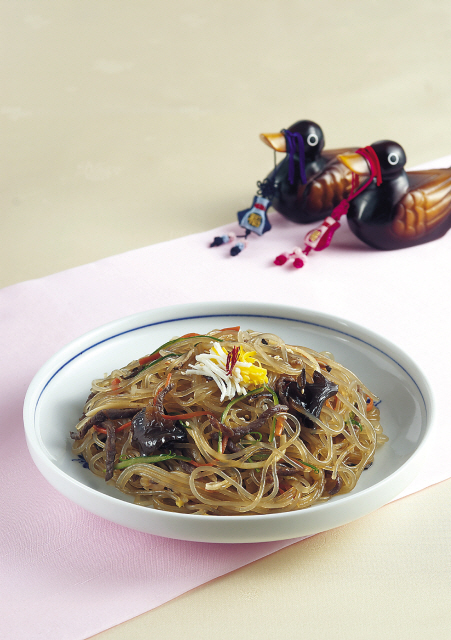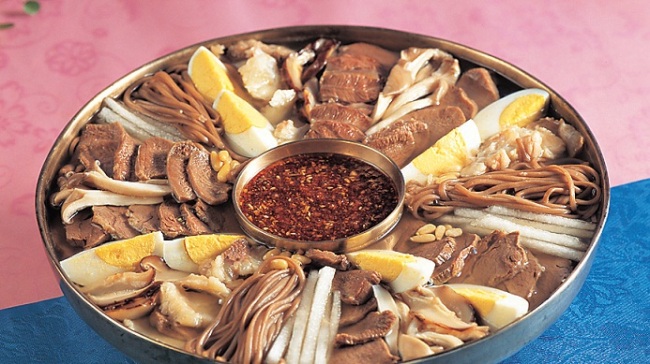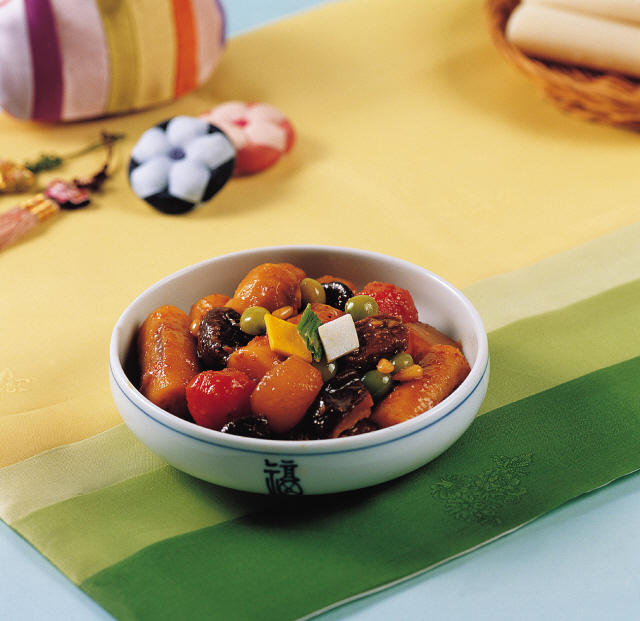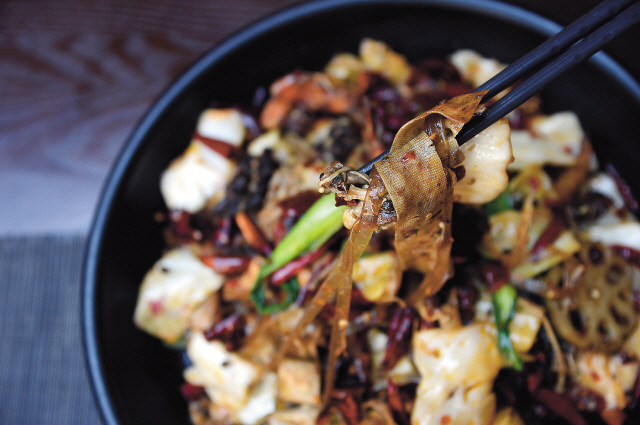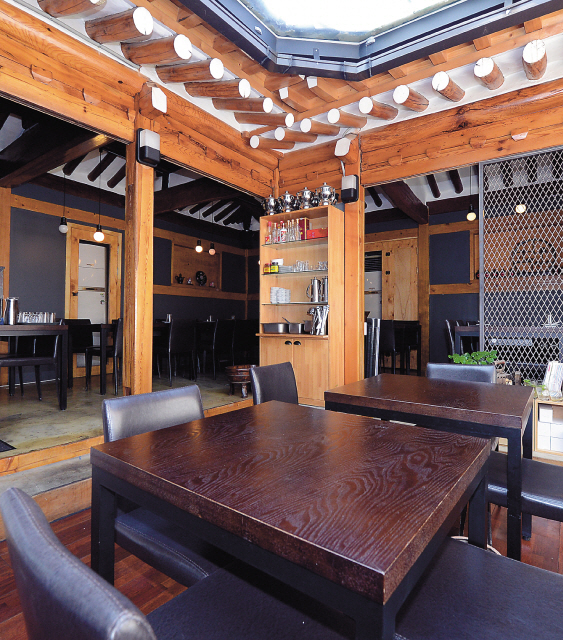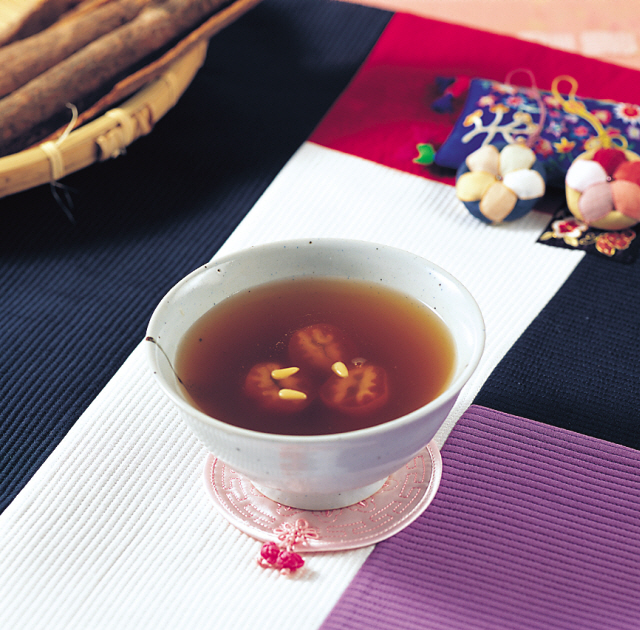Pairing Chuseok dishes with
green tea and handling leftoversWith a mere week left
till the nation celebrates one of South Korea’s biggest annual holidays, the
time has come to start gathering the necessary ingredients needed to prepare
traditional dishes for the ancestral “jesa” table next Sunday morning.
By now, Chuseok gifts have begun to trickle in. Generally food-related
and seasonal, these packages range from precious rows of pine mushrooms redolent
of early autumn to neatly arranged slabs of much-coveted hanwoo (Korean beef) to
near-translucent orbs of dried persimmons covered in a white, sweet frost.
Most of these delectable offerings will be used to whip up those Chuseok
goodies. Yet, what to do with the remaining bits and pieces?
Haap
owner-chef Sin Yong-il and Lotte Hotel Seoul’s Korean restaurant Mugunghwa
provide simple recipes for those precious leftover ingredients, while Ujeon
Green Tea master Kim Dong-gon pairs teas with Chuseok delicacies.
Brew matchIn Korea, tea generally refers to the green
version of the brew made from Camellia sinensis leaves.
The cultivation
of tea first began when it arrived from Tang Dynasty China around 1,000 years
ago, during the Unified Silla Period, and Hadong County in South Gyeongsang
Province, was one of the first regions where tea was planted.
Ssanggye
Tea Company CEO Kim Dong-gon ― appointed the 28th Korean Food Grand Master by
the Ministry for Food, Agriculture, Forestry and Fisheries ― hails from the
region, where he grows and produces around 50 varieties of tea and tisanes.
Kim is most famous for his mastery of ujeon green tea. Ujeoncha (“cha”
means “tea” in Korean) is made from the first flush (earliest leaves of the tea
plant) and is traditionally roasted in a cauldron over an oak wood fire. The
tradition of making ujeoncha has been passed down to Kim and it is his expertise
in the precious brew that has earned him the Grand Master title.
“This
is the earliest, when tea leaves are their most fragrant and delicious,” said
Kim, 64, in a phone interview, adding that the resulting ujeoncha is “soft,
aromatic and lingers long on the palate.”
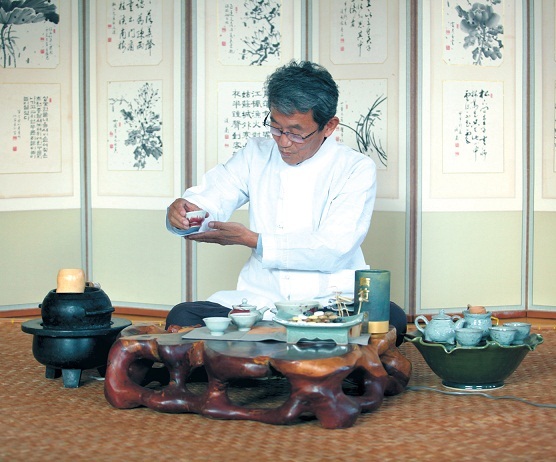 |
| Ssanggye Tea
Company CEO Kim Dong-gon conducts a tea ceremony. (Ssanggye Tea
Company) |
For pairing with dried persimmons,
Kim recommends jakseolcha as a reasonably-priced match. Harvested when still
tender, after ujeoncha during the same period as “sejak” tea, the leaves of
jakseolcha are believed to resemble the shape of a sparrow’s tongue.
Kim
suggests pairing jookro with songpyeon (filled rice cakes served during
Chuseok). Jookro, according to Kim, is made from leaves that have been raised on
the dew of bamboo and harvested in mid-May.
For meat and jeon (Korean
pancakes), Sejak tea ― which is harvested and made after Ujeon ― is a
recommended accompaniment.
‘Haap’-style tteok galbi
Owner-chef Sin Yong-il of tteok cafe Haap says tteok galbi is a
good way to use up leftover chestnuts, jujubes and meat from Chuseok. Even if
the peeled, raw chestnuts served during the holiday have browned a bit, it is
okay, says Sin, because everything gets minced and mixed together and spiced up
with some tasty seasonings.
Ingredients for tteok galbi:
- 400 g beef from the ribs (or any kind of leftover beef)
―
25 g Asian pear juice
― 4 finely chopped chestnuts
― 4 finely
chopped jujubes
― 5 g sticky rice powder
― Tteok for the
center
Ingredients for seasoning:― 2 tbsp soy
sauce
― 1 tbsp finely chopped garlic
― 2 tbsp finely chopped green
onions
― 2 tbsp sugar
― Honey to coat the tteok
galbi
Directions:1. Finely chop the chestnuts and
jujubes.
2. Prepare the Asian pear juice.
3. Make the seasoning by
finely chopping the garlic and green onions and mixing it with soy sauce and
sugar.
4. Trim about 80 percent of the fat off the rib meat and mince.
5. Mix together with seasoning sauce, kneading it like dough.
6.
Make globe-shaped patties, putting nubs of rice cake in the center and then
molding it over, ideally so that the tteok sticks out of the side of each patty
a little bit; 400 grams should make approximately 8 patties.
7. Coat
each patty with a little bit of honey.
8. First cook the outside of the
patties over medium heat in a frying pan before transferring to the oven and
baking at 170 degrees Celsius for about 7 to 8 minutes, adjusting as needed
depending on the size of the patties.
9. Coat patties in remaining honey
and serve.
Pine mushroom rice in stone potLotte Hotel
Seoul’s Korean restaurant Mugunghwa serves up rice cooked in stone pot, topped
with fragrant slices of the autumnal delicacy ― pine mushrooms. The rice is
paired with a special pine mushroom soy-based sauce that is meant to be mixed in
with the rice and enjoyed.
Ingredients for the pine mushroom
rice:― 200 g soaked white rice
― 170 g water
― 2 g
pine nuts
― 4 g peeled gingko biloba nuts
― 5 g cleaned pine
mushrooms
― A little sesame seed
oil
Directions:1. First make the pine mushroom sauce by
mixing four parts water to two parts soy sauce and one part sugar. Ratio-wise,
you will need one stalk of large green onion, one peeled onion and black pepper
to taste for approximately three liters of the sauce (should you choose to make
that much). Bring all ingredients to boil in a pot and then lower to medium heat
and let cook for about five minutes. After the sauce cools, strain out the onion
and green onion, and add finely chopped stems of pine mushrooms. Allow the sauce
to pickle for a day in the refrigerator.
2. Put all ingredients for the
pine mushroom rice, except for the pine mushrooms, in a stone pot and then boil
at high heat for 12 minutes. Then cook at low heat for five more minutes. Turn
off heat, add chopped pine mushrooms, close lid again and let the mushrooms
steam for an additional five minutes.
How to pick prepare pine
mushrooms:Mugunghwa chef de cuisine Chun Duk-sang provides tips on
selecting and washing pine mushrooms.
Chun recommends looking for
mushrooms with small, closed caps, a sign that it has retained its moisture, he
says.
When prepping the mushrooms, Chun says to gently trim off the
outside of the lower two-thirds of the stalk, which have been in the dirt, and
then to chop off a bit of the bottom of the stem. Then he says to take a kitchen
towel and gently wipe the top of the mushroom and the remaining upper, untrimmed
part of the stem. Finally, rinse the pine mushroom lightly in running
water.
Details
Haap, which opened a new cafe
near the Grand Hyatt Seoul in Itaewon-dong, is selling boxed tteok. Owner-chef
Sin Yong-il says tteok packaged in boxes made with wood from the royal foxglove
are popular Chuseok gifts. A new addition to the menu is injeolmi, which Sin
makes super-soft, then cuts and coats it in various flavors to
order.
Haap Namsan Cafe; 2F, 231-36 Itaewon-dong, Yongsan-gu, Seoul;
(070) 7532-4819; www.haap01.com; open noon to 9 p.m. daily (call in
advance)
Mugunghwa will be open during Chuseok and is currently serving
special pine mushroom dishes.
Mugunghwa; 38F, Lotte Hotel Seoul, 30,
Eulji-ro, Jung-gu, Seoul; (02) 317-7061; open 11:30 a.m. to 2:30 p.m., 6 p.m. to
10 p.m. daily
By Jean Oh (
oh_jean@heraldcorp.com)
